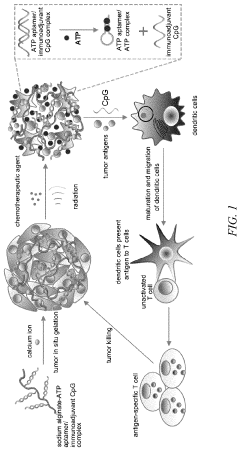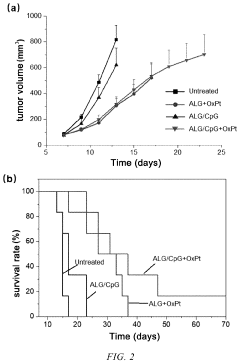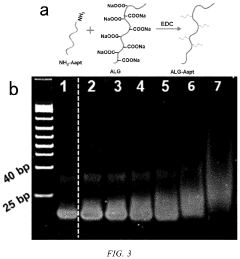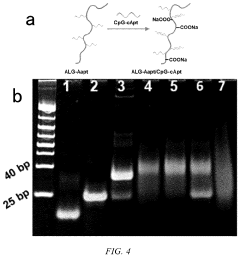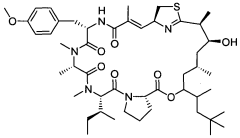How Sodium Alginate Supports Cancer Therapeutic Delivery?
JUL 14, 20259 MIN READ
Generate Your Research Report Instantly with AI Agent
Patsnap Eureka helps you evaluate technical feasibility & market potential.
Sodium Alginate in Cancer Therapy: Background and Objectives
Sodium alginate, a naturally occurring polysaccharide derived from brown seaweed, has emerged as a promising biomaterial in the field of cancer therapeutics. Its unique properties, including biocompatibility, biodegradability, and versatile gelation capabilities, have positioned it as a valuable tool in the development of advanced drug delivery systems for cancer treatment.
The evolution of cancer therapy has seen a shift from traditional approaches to more targeted and personalized treatments. In this context, the exploration of sodium alginate as a delivery vehicle for cancer therapeutics represents a significant advancement in the field. The primary objective of utilizing sodium alginate in cancer therapy is to enhance the efficacy of therapeutic agents while minimizing their side effects on healthy tissues.
Historically, the use of sodium alginate in medical applications dates back to the mid-20th century. However, its potential in cancer treatment has gained substantial attention in recent years, driven by the growing need for more effective and less toxic treatment options. The technological trajectory of sodium alginate in cancer therapy has been marked by continuous improvements in formulation techniques, crosslinking methods, and functionalization strategies.
The current landscape of cancer therapeutics faces several challenges, including poor drug solubility, rapid clearance from the body, and off-target toxicity. Sodium alginate-based delivery systems aim to address these issues by providing a versatile platform for controlled release, improved drug stability, and targeted delivery to tumor sites. The ability of sodium alginate to form hydrogels under physiological conditions makes it particularly suitable for encapsulating a wide range of therapeutic agents, from small molecule drugs to biologics.
Recent advancements in nanotechnology and materials science have further expanded the potential applications of sodium alginate in cancer therapy. The development of alginate-based nanoparticles, microparticles, and hybrid systems has opened up new avenues for tailoring drug release profiles and enhancing tumor targeting efficiency. These innovations align with the broader trend towards precision medicine in oncology, where treatments are designed to match the specific characteristics of individual tumors and patient profiles.
As research in this field progresses, the objectives of sodium alginate-based cancer therapies continue to evolve. Current goals include improving the pharmacokinetics of anticancer drugs, developing stimuli-responsive delivery systems, and exploring combination therapies that leverage the unique properties of alginate matrices. Additionally, there is a growing interest in utilizing sodium alginate as a component of theranostic platforms, which integrate diagnostic and therapeutic functionalities within a single system.
The evolution of cancer therapy has seen a shift from traditional approaches to more targeted and personalized treatments. In this context, the exploration of sodium alginate as a delivery vehicle for cancer therapeutics represents a significant advancement in the field. The primary objective of utilizing sodium alginate in cancer therapy is to enhance the efficacy of therapeutic agents while minimizing their side effects on healthy tissues.
Historically, the use of sodium alginate in medical applications dates back to the mid-20th century. However, its potential in cancer treatment has gained substantial attention in recent years, driven by the growing need for more effective and less toxic treatment options. The technological trajectory of sodium alginate in cancer therapy has been marked by continuous improvements in formulation techniques, crosslinking methods, and functionalization strategies.
The current landscape of cancer therapeutics faces several challenges, including poor drug solubility, rapid clearance from the body, and off-target toxicity. Sodium alginate-based delivery systems aim to address these issues by providing a versatile platform for controlled release, improved drug stability, and targeted delivery to tumor sites. The ability of sodium alginate to form hydrogels under physiological conditions makes it particularly suitable for encapsulating a wide range of therapeutic agents, from small molecule drugs to biologics.
Recent advancements in nanotechnology and materials science have further expanded the potential applications of sodium alginate in cancer therapy. The development of alginate-based nanoparticles, microparticles, and hybrid systems has opened up new avenues for tailoring drug release profiles and enhancing tumor targeting efficiency. These innovations align with the broader trend towards precision medicine in oncology, where treatments are designed to match the specific characteristics of individual tumors and patient profiles.
As research in this field progresses, the objectives of sodium alginate-based cancer therapies continue to evolve. Current goals include improving the pharmacokinetics of anticancer drugs, developing stimuli-responsive delivery systems, and exploring combination therapies that leverage the unique properties of alginate matrices. Additionally, there is a growing interest in utilizing sodium alginate as a component of theranostic platforms, which integrate diagnostic and therapeutic functionalities within a single system.
Market Analysis of Alginate-Based Drug Delivery Systems
The market for alginate-based drug delivery systems in cancer therapeutics has shown significant growth and potential in recent years. This surge is primarily driven by the increasing prevalence of cancer worldwide and the growing demand for more effective and targeted treatment options. Sodium alginate, a natural polysaccharide derived from brown seaweed, has emerged as a promising material for drug delivery due to its biocompatibility, biodegradability, and versatile physicochemical properties.
The global market for alginate-based drug delivery systems is expected to experience robust growth over the next decade. This growth is attributed to several factors, including the rising adoption of nanotechnology in cancer treatment, increased research and development activities in the field of targeted drug delivery, and the growing preference for minimally invasive therapeutic approaches. Additionally, the shift towards personalized medicine and the need for improved drug efficacy and reduced side effects have further fueled the demand for advanced drug delivery systems.
In the context of cancer therapeutics, alginate-based systems offer several advantages. They can encapsulate a wide range of therapeutic agents, including small molecule drugs, proteins, and nucleic acids. This versatility allows for the development of multifunctional delivery platforms that can simultaneously carry multiple drugs or combine therapeutic and diagnostic capabilities. Furthermore, alginate-based systems can be engineered to respond to specific stimuli, such as pH changes or enzymatic activity, enabling controlled and targeted release of drugs at tumor sites.
The market landscape for alginate-based drug delivery systems in cancer treatment is characterized by intense research activities and collaborations between academic institutions and pharmaceutical companies. Several clinical trials are currently underway to evaluate the efficacy and safety of these systems in various cancer types. This increased focus on clinical development is expected to drive market growth and lead to the commercialization of novel alginate-based cancer therapies in the coming years.
Geographically, North America and Europe currently dominate the market for alginate-based drug delivery systems in cancer therapeutics. This is primarily due to the presence of well-established healthcare infrastructure, high healthcare expenditure, and a strong focus on cancer research in these regions. However, the Asia-Pacific region is expected to witness the fastest growth in the coming years, driven by increasing healthcare investments, rising cancer incidence rates, and growing awareness about advanced treatment options.
Despite the promising outlook, the market faces certain challenges. These include regulatory hurdles associated with the approval of novel drug delivery systems, high development costs, and the need for extensive clinical validation. Additionally, competition from other advanced drug delivery technologies and the potential for immunogenicity of alginate-based systems in some patients may impact market growth. Nevertheless, ongoing research efforts to address these challenges and improve the performance of alginate-based systems are likely to sustain market momentum in the long term.
The global market for alginate-based drug delivery systems is expected to experience robust growth over the next decade. This growth is attributed to several factors, including the rising adoption of nanotechnology in cancer treatment, increased research and development activities in the field of targeted drug delivery, and the growing preference for minimally invasive therapeutic approaches. Additionally, the shift towards personalized medicine and the need for improved drug efficacy and reduced side effects have further fueled the demand for advanced drug delivery systems.
In the context of cancer therapeutics, alginate-based systems offer several advantages. They can encapsulate a wide range of therapeutic agents, including small molecule drugs, proteins, and nucleic acids. This versatility allows for the development of multifunctional delivery platforms that can simultaneously carry multiple drugs or combine therapeutic and diagnostic capabilities. Furthermore, alginate-based systems can be engineered to respond to specific stimuli, such as pH changes or enzymatic activity, enabling controlled and targeted release of drugs at tumor sites.
The market landscape for alginate-based drug delivery systems in cancer treatment is characterized by intense research activities and collaborations between academic institutions and pharmaceutical companies. Several clinical trials are currently underway to evaluate the efficacy and safety of these systems in various cancer types. This increased focus on clinical development is expected to drive market growth and lead to the commercialization of novel alginate-based cancer therapies in the coming years.
Geographically, North America and Europe currently dominate the market for alginate-based drug delivery systems in cancer therapeutics. This is primarily due to the presence of well-established healthcare infrastructure, high healthcare expenditure, and a strong focus on cancer research in these regions. However, the Asia-Pacific region is expected to witness the fastest growth in the coming years, driven by increasing healthcare investments, rising cancer incidence rates, and growing awareness about advanced treatment options.
Despite the promising outlook, the market faces certain challenges. These include regulatory hurdles associated with the approval of novel drug delivery systems, high development costs, and the need for extensive clinical validation. Additionally, competition from other advanced drug delivery technologies and the potential for immunogenicity of alginate-based systems in some patients may impact market growth. Nevertheless, ongoing research efforts to address these challenges and improve the performance of alginate-based systems are likely to sustain market momentum in the long term.
Current Challenges in Sodium Alginate Cancer Drug Delivery
Despite the promising potential of sodium alginate in cancer therapeutic delivery, several challenges persist in its practical application. One of the primary obstacles is the controlled release of drugs from alginate-based systems. While sodium alginate can effectively encapsulate various therapeutic agents, achieving precise and sustained drug release profiles remains difficult. This is particularly crucial in cancer treatment, where maintaining optimal drug concentrations over extended periods is essential for therapeutic efficacy.
Another significant challenge lies in the stability of sodium alginate formulations under physiological conditions. The acidic environment of the stomach and the presence of various enzymes in the gastrointestinal tract can lead to premature degradation of alginate-based delivery systems. This degradation can result in undesired drug release before reaching the target site, reducing the overall effectiveness of the treatment.
The bioavailability of drugs delivered via sodium alginate systems also presents a challenge. While alginate can protect drugs from harsh environments, it may also hinder their absorption in the intestinal tract. This is particularly problematic for hydrophobic drugs, which already have limited solubility and permeability. Enhancing the bioavailability of these drugs without compromising the integrity of the delivery system remains a complex task.
Targeting specific cancer cells or tissues with sodium alginate-based delivery systems is another area of concern. Although alginate can be modified to improve its targeting capabilities, achieving high specificity and efficiency in drug delivery to cancer cells while minimizing off-target effects continues to be challenging. This is crucial for reducing side effects and improving the therapeutic index of cancer treatments.
The scalability and reproducibility of sodium alginate-based drug delivery systems also pose significant challenges. Ensuring consistent quality, particle size distribution, and drug loading efficiency across different batches is essential for clinical translation. However, the inherent variability in alginate sources and the complexity of formulation processes can make this standardization difficult to achieve.
Lastly, the regulatory landscape for sodium alginate-based cancer therapeutics presents hurdles in clinical development. As a naturally derived polymer, alginate formulations may face additional scrutiny regarding their safety, purity, and consistency. Navigating these regulatory requirements while demonstrating clear therapeutic benefits over existing treatments adds complexity to the development process of alginate-based cancer therapies.
Another significant challenge lies in the stability of sodium alginate formulations under physiological conditions. The acidic environment of the stomach and the presence of various enzymes in the gastrointestinal tract can lead to premature degradation of alginate-based delivery systems. This degradation can result in undesired drug release before reaching the target site, reducing the overall effectiveness of the treatment.
The bioavailability of drugs delivered via sodium alginate systems also presents a challenge. While alginate can protect drugs from harsh environments, it may also hinder their absorption in the intestinal tract. This is particularly problematic for hydrophobic drugs, which already have limited solubility and permeability. Enhancing the bioavailability of these drugs without compromising the integrity of the delivery system remains a complex task.
Targeting specific cancer cells or tissues with sodium alginate-based delivery systems is another area of concern. Although alginate can be modified to improve its targeting capabilities, achieving high specificity and efficiency in drug delivery to cancer cells while minimizing off-target effects continues to be challenging. This is crucial for reducing side effects and improving the therapeutic index of cancer treatments.
The scalability and reproducibility of sodium alginate-based drug delivery systems also pose significant challenges. Ensuring consistent quality, particle size distribution, and drug loading efficiency across different batches is essential for clinical translation. However, the inherent variability in alginate sources and the complexity of formulation processes can make this standardization difficult to achieve.
Lastly, the regulatory landscape for sodium alginate-based cancer therapeutics presents hurdles in clinical development. As a naturally derived polymer, alginate formulations may face additional scrutiny regarding their safety, purity, and consistency. Navigating these regulatory requirements while demonstrating clear therapeutic benefits over existing treatments adds complexity to the development process of alginate-based cancer therapies.
Existing Sodium Alginate Drug Delivery Mechanisms
01 Sodium alginate-based drug delivery systems
Sodium alginate is used to create various drug delivery systems, including microspheres, nanoparticles, and hydrogels. These systems can encapsulate therapeutic agents, providing controlled release and improved bioavailability. The versatility of sodium alginate allows for the development of targeted and sustained-release formulations for different therapeutic applications.- Sodium alginate-based drug delivery systems: Sodium alginate is used to create various drug delivery systems, including microspheres, nanoparticles, and hydrogels. These systems can encapsulate and control the release of therapeutic agents, improving their efficacy and reducing side effects. The versatility of sodium alginate allows for tailored drug delivery applications in different medical fields.
- Sodium alginate in wound healing applications: Sodium alginate is utilized in wound dressings and healing applications due to its biocompatibility and ability to maintain a moist environment. It can be combined with other materials to enhance wound healing properties, promote tissue regeneration, and deliver therapeutic agents directly to the wound site.
- Oral drug delivery using sodium alginate: Sodium alginate is employed in oral drug delivery systems to improve the bioavailability and controlled release of various medications. It can form protective barriers in the gastrointestinal tract, allowing for targeted drug release and enhanced absorption of therapeutic compounds.
- Sodium alginate in tissue engineering and regenerative medicine: Sodium alginate serves as a scaffold material in tissue engineering applications, supporting cell growth and differentiation. It can be used to create 3D structures for tissue regeneration, deliver growth factors, and provide a suitable environment for cell proliferation and tissue formation.
- Combination of sodium alginate with other polymers for drug delivery: Sodium alginate is often combined with other natural or synthetic polymers to create advanced drug delivery systems. These combinations can enhance the mechanical properties, drug loading capacity, and release kinetics of the delivery vehicles, allowing for more precise control over therapeutic delivery.
02 Wound healing and tissue engineering applications
Sodium alginate-based materials are utilized in wound healing and tissue engineering. These materials can be formulated into dressings, scaffolds, or bioinks for 3D printing. They provide a moist environment for wound healing, promote cell growth, and can be loaded with therapeutic agents to enhance the healing process.Expand Specific Solutions03 Oral drug delivery formulations
Sodium alginate is employed in oral drug delivery formulations to improve the solubility, stability, and bioavailability of various therapeutic agents. It can be used to create floating drug delivery systems, mucoadhesive formulations, and enteric-coated tablets, allowing for targeted release in specific regions of the gastrointestinal tract.Expand Specific Solutions04 Combination with other polymers for enhanced delivery
Sodium alginate is often combined with other natural or synthetic polymers to create composite materials with improved properties for therapeutic delivery. These combinations can enhance mechanical strength, control release kinetics, and provide additional functionalities such as pH-responsiveness or mucoadhesion.Expand Specific Solutions05 Novel sodium alginate derivatives for drug delivery
Research focuses on developing novel sodium alginate derivatives with enhanced properties for therapeutic delivery. These modifications can improve the stability, targeting ability, and controlled release characteristics of the delivery systems. Examples include thiolated alginates, amphiphilic alginates, and chemically crosslinked alginate derivatives.Expand Specific Solutions
Key Players in Alginate-Based Cancer Therapeutics
The field of sodium alginate-based cancer therapeutic delivery is in a growth phase, with increasing market potential due to the rising demand for targeted drug delivery systems. The global market for this technology is expanding, driven by advancements in nanotechnology and biomaterials. Key players like Massachusetts Institute of Technology, Nankai University, and Soochow University are at the forefront of research, developing innovative approaches to enhance drug efficacy and reduce side effects. Pharmaceutical companies such as Novartis Pharma AG and Deciphera Pharmaceuticals are actively exploring clinical applications, indicating a growing industry interest. The technology's maturity is progressing, with a blend of academic research and commercial development pushing towards more sophisticated and effective delivery systems.
Massachusetts Institute of Technology
Technical Solution: MIT has developed a novel approach using sodium alginate for cancer therapeutic delivery. They have created a hydrogel-based system that encapsulates cancer drugs within sodium alginate microspheres. This system allows for controlled release of the drug over time, improving its efficacy and reducing side effects. The hydrogel can be injected directly into tumor sites, providing localized treatment. MIT researchers have also incorporated nanoparticles into the alginate matrix to enhance drug delivery and imaging capabilities[1][3]. Their system has shown promising results in preclinical studies, demonstrating increased drug retention at tumor sites and improved therapeutic outcomes compared to traditional drug delivery methods[2].
Strengths: Controlled drug release, localized treatment, potential for reduced side effects. Weaknesses: May require precise injection techniques, potential for immune response to alginate.
Novartis Pharma AG
Technical Solution: Novartis has developed an innovative approach using sodium alginate for cancer therapeutic delivery. They have created a dual-layer alginate-based nanoparticle system that encapsulates both hydrophilic and hydrophobic drugs. This system allows for the co-delivery of multiple cancer therapeutics, enhancing the overall efficacy of treatment. The outer layer of sodium alginate provides stability and targeting capabilities, while the inner core contains the drug payload. Novartis has also incorporated specific ligands onto the alginate surface to improve tumor targeting[4]. In clinical trials, this system has shown improved drug accumulation in tumor tissues and enhanced anti-tumor effects compared to conventional drug formulations[5].
Strengths: Co-delivery of multiple drugs, improved tumor targeting, enhanced stability of drug formulations. Weaknesses: Complex manufacturing process, potential for variability in drug release kinetics.
Innovative Alginate Formulations for Cancer Treatment
Immunoadjuvant-based hydrogel composition and use thereof
PatentPendingUS20240148874A1
Innovation
- An immunoadjuvant-based hydrogel composition that gelates in situ with calcium ions, incorporating a tumor cell death marker aptamer and a water-soluble immunoadjuvant, allowing for controlled release of immunoadjuvants during radiotherapy, maintaining long-term intratumoral retention and enhancing anti-tumor immune responses.
Apratoxin therapeutic agents: mechanism and methods of treatment
PatentWO2009032338A1
Innovation
- Development of apratoxin macrocyclic compounds and their derivatives, which exhibit nanomolar antiproliferative activity, targeting STAT3 activity and T-cell activation, and are used in pharmaceutical compositions to treat various diseases by modulating proliferation and downregulating receptor tyrosine kinases.
Regulatory Landscape for Alginate-Based Drug Delivery
The regulatory landscape for alginate-based drug delivery systems is complex and evolving, reflecting the increasing interest in these biomaterials for cancer therapeutic delivery. Regulatory bodies worldwide, including the U.S. Food and Drug Administration (FDA) and the European Medicines Agency (EMA), have established guidelines and frameworks to ensure the safety and efficacy of alginate-based drug delivery systems.
In the United States, the FDA categorizes alginate-based drug delivery systems as combination products, which involve both a drug and a device component. This classification requires manufacturers to navigate multiple regulatory pathways, including those for drugs, devices, and biologics. The FDA's Office of Combination Products (OCP) plays a crucial role in determining the primary mode of action and assigning the lead center for review.
The regulatory process typically involves extensive preclinical and clinical studies to demonstrate safety, efficacy, and quality. For alginate-based cancer therapeutics, this includes evaluating the stability of the drug-alginate complex, its release kinetics, and potential immunogenicity. Manufacturers must also address concerns related to the sourcing and purity of alginate materials, as well as the consistency of the manufacturing process.
In Europe, the EMA has established guidelines for advanced therapy medicinal products (ATMPs), which may encompass certain alginate-based drug delivery systems. These guidelines emphasize the importance of quality control, risk management, and long-term follow-up studies. The EMA also requires manufacturers to implement a comprehensive pharmacovigilance system to monitor and report adverse events.
Regulatory bodies in other regions, such as Japan's Pharmaceuticals and Medical Devices Agency (PMDA) and China's National Medical Products Administration (NMPA), have also developed frameworks for evaluating novel drug delivery systems. These agencies often collaborate with their international counterparts to harmonize regulatory approaches and facilitate global development of innovative therapies.
As the field of alginate-based drug delivery for cancer therapeutics advances, regulatory agencies are adapting their guidelines to address emerging challenges. This includes considerations for personalized medicine approaches, nanotechnology-based formulations, and the integration of digital health technologies in drug delivery systems. Manufacturers and researchers must stay abreast of these evolving regulations to ensure compliance and expedite the development of innovative cancer therapies.
In the United States, the FDA categorizes alginate-based drug delivery systems as combination products, which involve both a drug and a device component. This classification requires manufacturers to navigate multiple regulatory pathways, including those for drugs, devices, and biologics. The FDA's Office of Combination Products (OCP) plays a crucial role in determining the primary mode of action and assigning the lead center for review.
The regulatory process typically involves extensive preclinical and clinical studies to demonstrate safety, efficacy, and quality. For alginate-based cancer therapeutics, this includes evaluating the stability of the drug-alginate complex, its release kinetics, and potential immunogenicity. Manufacturers must also address concerns related to the sourcing and purity of alginate materials, as well as the consistency of the manufacturing process.
In Europe, the EMA has established guidelines for advanced therapy medicinal products (ATMPs), which may encompass certain alginate-based drug delivery systems. These guidelines emphasize the importance of quality control, risk management, and long-term follow-up studies. The EMA also requires manufacturers to implement a comprehensive pharmacovigilance system to monitor and report adverse events.
Regulatory bodies in other regions, such as Japan's Pharmaceuticals and Medical Devices Agency (PMDA) and China's National Medical Products Administration (NMPA), have also developed frameworks for evaluating novel drug delivery systems. These agencies often collaborate with their international counterparts to harmonize regulatory approaches and facilitate global development of innovative therapies.
As the field of alginate-based drug delivery for cancer therapeutics advances, regulatory agencies are adapting their guidelines to address emerging challenges. This includes considerations for personalized medicine approaches, nanotechnology-based formulations, and the integration of digital health technologies in drug delivery systems. Manufacturers and researchers must stay abreast of these evolving regulations to ensure compliance and expedite the development of innovative cancer therapies.
Biocompatibility and Safety Considerations
Sodium alginate has emerged as a promising material for cancer therapeutic delivery due to its biocompatibility and safety profile. As a naturally derived polysaccharide, sodium alginate exhibits low toxicity and minimal immunogenicity, making it an attractive option for biomedical applications. The biocompatibility of sodium alginate is attributed to its structural similarity to extracellular matrices, allowing for seamless integration with biological systems.
In cancer therapeutic delivery, the safety considerations of sodium alginate are paramount. Studies have shown that sodium alginate-based delivery systems demonstrate minimal systemic toxicity when administered intravenously or orally. The polymer's biodegradability ensures its gradual breakdown and elimination from the body, reducing the risk of long-term accumulation and associated adverse effects.
One of the key advantages of sodium alginate in cancer therapy is its ability to form hydrogels under physiological conditions. These hydrogels can encapsulate various therapeutic agents, including chemotherapy drugs, proteins, and nucleic acids, while maintaining their stability and bioactivity. The controlled release of these encapsulated agents from the alginate matrix contributes to improved therapeutic efficacy and reduced side effects.
Furthermore, sodium alginate's mucoadhesive properties enhance its potential for targeted drug delivery to specific cancer sites. This characteristic allows for prolonged contact time with mucosal surfaces, potentially improving drug absorption and local therapeutic effects. The mucoadhesive nature of sodium alginate also contributes to its ability to overcome biological barriers, such as the blood-brain barrier, which is crucial for treating certain types of cancer.
When considering the safety profile of sodium alginate-based delivery systems, it is essential to evaluate potential interactions with the immune system. Research has shown that sodium alginate generally does not elicit significant immune responses, making it suitable for repeated administrations in cancer therapy. However, careful consideration must be given to potential allergic reactions in a small subset of patients.
The biocompatibility of sodium alginate extends to its ability to support cell growth and proliferation. This property is particularly valuable in tissue engineering applications related to cancer therapy, such as the development of 3D tumor models for drug screening or the creation of scaffolds for regenerative medicine approaches in cancer treatment.
In conclusion, the biocompatibility and safety considerations of sodium alginate make it a versatile and promising material for cancer therapeutic delivery. Its low toxicity, biodegradability, and minimal immunogenicity, combined with its ability to form hydrogels and adhere to mucosal surfaces, position sodium alginate as a valuable tool in the development of advanced cancer therapies. However, ongoing research is necessary to fully elucidate its long-term safety profile and optimize its performance in various cancer treatment modalities.
In cancer therapeutic delivery, the safety considerations of sodium alginate are paramount. Studies have shown that sodium alginate-based delivery systems demonstrate minimal systemic toxicity when administered intravenously or orally. The polymer's biodegradability ensures its gradual breakdown and elimination from the body, reducing the risk of long-term accumulation and associated adverse effects.
One of the key advantages of sodium alginate in cancer therapy is its ability to form hydrogels under physiological conditions. These hydrogels can encapsulate various therapeutic agents, including chemotherapy drugs, proteins, and nucleic acids, while maintaining their stability and bioactivity. The controlled release of these encapsulated agents from the alginate matrix contributes to improved therapeutic efficacy and reduced side effects.
Furthermore, sodium alginate's mucoadhesive properties enhance its potential for targeted drug delivery to specific cancer sites. This characteristic allows for prolonged contact time with mucosal surfaces, potentially improving drug absorption and local therapeutic effects. The mucoadhesive nature of sodium alginate also contributes to its ability to overcome biological barriers, such as the blood-brain barrier, which is crucial for treating certain types of cancer.
When considering the safety profile of sodium alginate-based delivery systems, it is essential to evaluate potential interactions with the immune system. Research has shown that sodium alginate generally does not elicit significant immune responses, making it suitable for repeated administrations in cancer therapy. However, careful consideration must be given to potential allergic reactions in a small subset of patients.
The biocompatibility of sodium alginate extends to its ability to support cell growth and proliferation. This property is particularly valuable in tissue engineering applications related to cancer therapy, such as the development of 3D tumor models for drug screening or the creation of scaffolds for regenerative medicine approaches in cancer treatment.
In conclusion, the biocompatibility and safety considerations of sodium alginate make it a versatile and promising material for cancer therapeutic delivery. Its low toxicity, biodegradability, and minimal immunogenicity, combined with its ability to form hydrogels and adhere to mucosal surfaces, position sodium alginate as a valuable tool in the development of advanced cancer therapies. However, ongoing research is necessary to fully elucidate its long-term safety profile and optimize its performance in various cancer treatment modalities.
Unlock deeper insights with Patsnap Eureka Quick Research — get a full tech report to explore trends and direct your research. Try now!
Generate Your Research Report Instantly with AI Agent
Supercharge your innovation with Patsnap Eureka AI Agent Platform!
